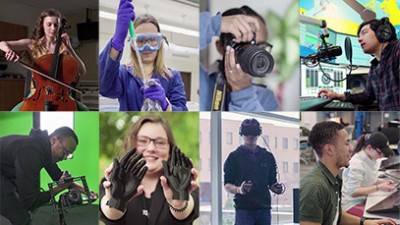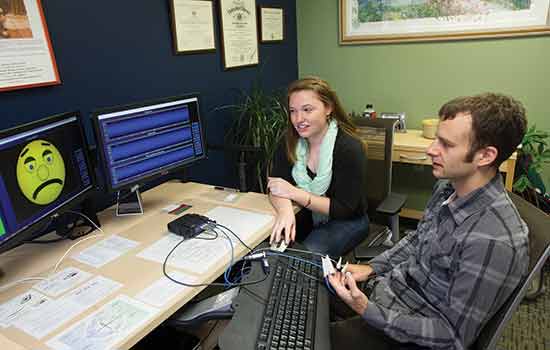Learn to manage your stress with biofeedback
A. Sue Weisler
Learn to manage stress with biofeedback technology at Imagine RIT. Here, Anna Hope and Brian Garrison from the Center for Applied Psychophysiology and Self-Regulation, demonstrate biofeedback equipment.
Health science and technology converge at Imagine RIT: Innovation and Creativity Festival on May 3 at the exhibit Biofeedback: Where Body is Mind, in the Gordon Field House.
Members of RIT’s Center for Applied Psychophysiology and Self-Regulation in the Institute/College of Health Sciences and Technology will show visitors how biofeedback can transform stress management.
Visitors will interact with the Dynamic Feedback Signal Set, which combines measures of the fight or flight response to show a person’s stress level in new ways. Sensors attached to fingertips and around the waist will measure heart rate, heart rate variability, respiration rate, skin conductance level and skin temperature.
The team from the Center for Applied Psychophysiology and Self-Regulation will explain how the signals relate to stress or comfort. Visitors will explore the mind-body connection by using the computer screen like a mirror and learning to control their stress response.
Dr. Laurence Sugarman, research professor and director of the center and a pediatrician at Easter Seals Diagnostic and Treatment Center, developed the Dynamic Feedback Signal Set to teach children with autism how to interpret their bodies’ stress signals and when to use calming techniques to help themselves feel better.
The therapeutic technology can help anyone practice being calm, Sugarman said.
“Innovative technologies show us our body process so that we can control them in healthy ways. We realize that nothing is involuntary once we learn about it. That’s a powerful feeling.”
The team of exhibitors from the Center for Applied Psychophysiology and Self-Regulation include director Laurence Sugarman; research coordinators Brian Garrison and Anna Hope; and students Kelsey Williford, Jordan Grimshaw, Michael Wezalis and Christine Zhou.









